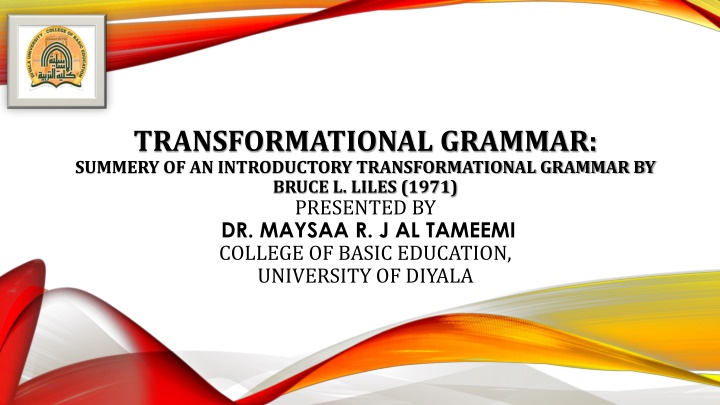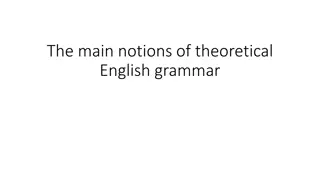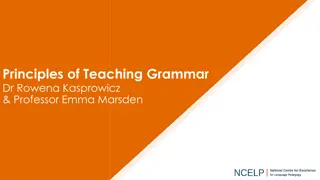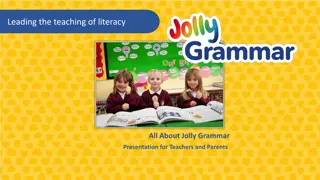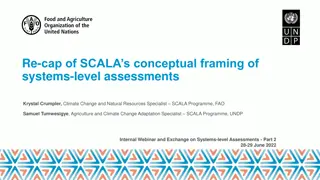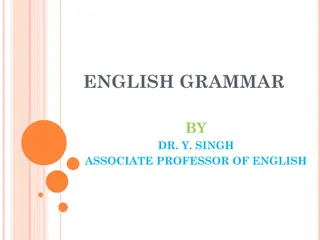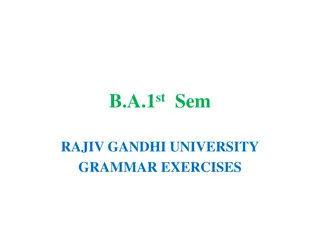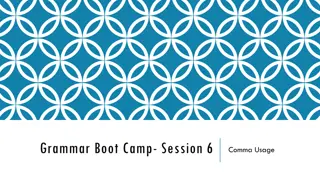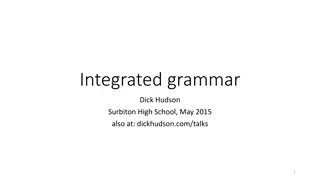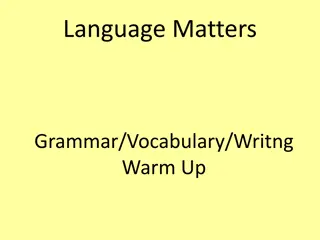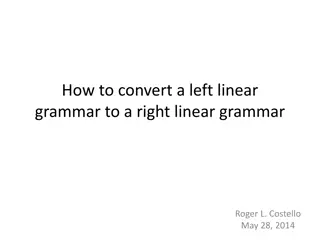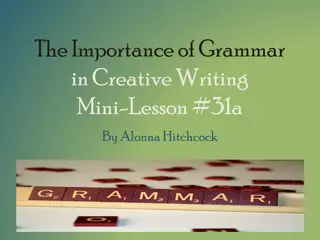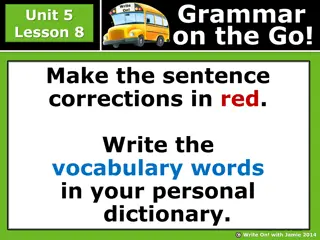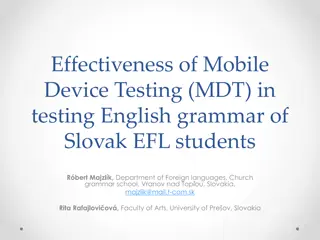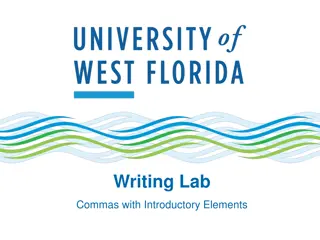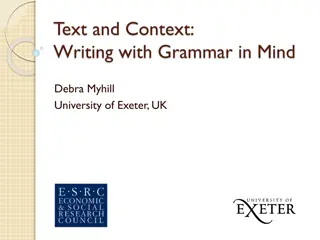Introductory Transformational Grammar Overview
An overview of Traditional Grammar, Structural Grammar, and Transformational Grammar, highlighting the evolution from Latin influence to modern structural analysis. Traditional grammar's focus on Latin structure, the shift to English as the language of scholarship, and dissatisfaction leading to the development of structural linguistics are explored.
Download Presentation

Please find below an Image/Link to download the presentation.
The content on the website is provided AS IS for your information and personal use only. It may not be sold, licensed, or shared on other websites without obtaining consent from the author.If you encounter any issues during the download, it is possible that the publisher has removed the file from their server.
You are allowed to download the files provided on this website for personal or commercial use, subject to the condition that they are used lawfully. All files are the property of their respective owners.
The content on the website is provided AS IS for your information and personal use only. It may not be sold, licensed, or shared on other websites without obtaining consent from the author.
E N D
Presentation Transcript
TRANSFORMATIONAL GRAMMAR: SUMMERY OF AN INTRODUCTORY TRANSFORMATIONAL GRAMMAR BY BRUCE L. LILES (1971) PRESENTED BY DR. MAYSAA R. J AL TAMEEMI COLLEGE OF BASIC EDUCATION, UNIVERSITY OF DIYALA
Chapter One TRADITIONAL GRAMMAR, STRUCTURAL GRAMMAR AND TRANSFORMATIONAL GRAMMAR Traditional Grammar: 1. Until the sixteenth Century, Latin was the primary language of scholarship in England and the rest of western Europe. Thus the grammar of Latin was taught at schools as a model for English Language in spite of the difference in the structure of the two languages. 2. While in English grammar a sentence meaning is governed by the words order, in Latin it is governed by words forms. 3. During the Renaissance, Latin was replaced by English as the language of Scholarship thus by late seventeenth and early eighteenth century, more attention and refining was given to English language.
4. English grammar rules were described according to logic not to what educated people were saying following the patterns set by grammars of the preceding two centuries. From this tradition developed the English grammars used in schools during the nineteenth and twentieth centuries. 5. This traditional grammar followed Latin grammar in concentrating on parts of speech that are subcategorized according to case, person, number, gender, mood, tense, etc. These concepts are informative in a study of Latin, but many of the categories are hard to justify for English. Word order was usually ignored.
STRUCTURAL GRAMMAR 1. During the nineteenth century, and after comparing large numbers of languages, many scholars found out that English is radically different in structure from Latin, they saw that traditional grammar was inadequate. 2. This dissatisfaction with traditional grammar continued into the twentieth century, Grammarians discovered that it would not account for many ordinary sentences in modern newspapers and magazines; in their teaching they were relying more upon observations they had made about the language than upon explanations in the texts. 3. Discontent with traditional grammar grew to such proportions that during the second quarter of the twentieth century a new approach to the study of language evolved: structural linguistics. 4. It studied the structure of a language as objectively as possible without reference to any other language, thinking that meaning was a poor guide to the analysis of structure. They attempted to analyze other grammatical elements in terms of structure rather than meaning. Instead of talking about what a noun means ( the name of a person, place, or thing ), for example, they began looking for other devices to identify nouns. In a sentence such as The arguments became heated, they said that the word arguments can be recognized as a noun because it has a plural ending, the suffix -ment, it follows the determiner the, and because it precedes the verb became .
STRUCTURAL GRAMMAR 4. The work of the structuralists focused on the word linguist , a term that had previously been used to designate someone who studied languages, particularly someone who spoke several different languages. But after the publication of Leonard Bloomfield s Language in 1933, the term linguist became specialized to mean only the person concerned with the new scientific study of language . The word linguistics became popular as the name of his discipline. Until the late 1950 s, the terms structuralists and linguists were practically synonymous in America. The structuralists made many prominent contributions to the study of language. They challenged current attitudes and began the scholarly study of language that has rapidly increased during the last two decades.
TRANSFORMATIONAL GRAMMAR 1. Starting formally in 1957 with the publication of Noam Chomsky s Syntactic Structures, a new approach to the study of language was started.This newer grammar has gone under various names: generative, transformational, generative-transformational, and transformational-generative. 2. The transformational grammarian is not content with describing what he finds in a corpus of sentences collected from native speakers. He feels that his grammar should enable one to produce all the sentences of a language, and he is as interested in possible sentences as he is in the ones actually recorded. Since the number of possible sentences in English or any other language is infinite. 3. They believe that An adequate grammar of English should enable a person to produce not just those sentences that have been said in the past, but all the sentences that a native speaker is capable of creating or understanding. In addition, the grammar should not generate sentences that a native speaker would reject, such as *The man horrified the door or *Boy on the roof is.
TRANSFORMATIONAL GRAMMAR 4. Speech may be affected by physical surroundings, emotions, memory limitations, distractions, or other features such as chewing gum in the mouth of the speaker. It is language (the underlying system), not actual speech output, that is of primary interest to the transformationalist. In other words, transformationalist is interested in the speaker s competence, or knowledge of the language, rather than in his performance, or actual use of it. 5. Sometimes, transformational grammar is similar to traditional grammar as Transformational grammar assigns each sentence an underlying structure that is called a deep structure, traditional grammars used a similar concept which is understood elements. For example, they said that Tom is taller than I has the underlying form Tom is taller than I am tall and that imperative sentences such as Come here have an understood subject you. Transformational grammarians agree, but apply this idea of underlying structure to every sentence and express it in a more abstract form than traditional grammarians did. 6. As transformationalists began studying deep structures, they noticed that languages which are quite different on the surface often show many similar features in their deep structures. Thus they stated that a universal deep structure is underlying all languages. Sentences having this universal deep structure are converted into the sentences of particular languages by a process known as transformation.
CHAPTER TWO SENTENCE STRUCTURE AND PHRASE STRUCTURE RULES Transformational grammar believes that a sentence consists of an optional sentence modifier and an obligatory nucleus; a nucleus (Nuc) consists of a noun phrase and a verb phrase, i.e., the sentence may or may not contain it, but every sentence must include a nucleus.This fact is represented in phrase structure rule number 1. In the second rule the fact that NP and VP are not in parentheses indicates that both are necessary for every sentence in English. The rules also indicate the order in which elements must be selected: the sentence modifier must come first, then the nucleus; in the nucleus the noun phrase must come first, then the verb phrase. Abbreviations used in this grammar are as follows: S is used to refer to a sentence while sentence modifier is abbreviated SM, noun phrase is NP, and verb phrase is VP. Rules in a transformational grammar are expressed in the following way: S (SM) Nuc Nuc NP + VP The arrow means consists of or is to be rewritten as.
Sentence Structure A sentence modifier (SM) It is a word or group of words like yes, no, certainly, naturally, maybe, perhaps, possibly, in fact, to be sure, or obviously. e.g. Yes, that woman drinks coffee The SM is yes, and the Nuc is that woman drinks coffee; in the Nuc, the NP is that woman, and the VP is drinks coffee. For example The sentence Yes, that man drinks milkis represented as follows: S SM NUC NP VP P1: S ?(SM) Nuc P2: Nuc ?NP + VP
SENTENCE STRUCTURE Noun Phrase (NP) It always contains a nominal (N.) which may be a pronoun (she, he , it, ,,etc) or a noun (Ali, Book, river, etc.) and sometimes preceded by a det. (a, an, some, all, few, etc). It is represented by the following rule where det is optional and number, i.e pluralization thus been put between brackets; P7: NP (Det) N (pl) e.g These girls are happy. NUC S NP VP Det N Pl these girls s
SENTENCE STRUCTURE Verb phrase It may be verb to be (be) or main verb (MV) which both should show tense whether in past, present or future. P6: MV NP be Place AP V (NP) 1. be + NP This book is a text. 2. be + Place Rula was in the car 3. be + AP She was very rude. 4. v Ali ran 5. v + NP Bill sold the tickets.
PHRASE STRUCTURE RULES Phrase Structure Rules are as follow: P1:S (SM) Nuc P2: Nuc NP + VP P3: VP Aux + MV (manner) (place) (time) P4: Aux tense (M) (have+en) (be +ing) P5: Tense present Past P6: MV be NP AP Place V (NP) P7: NP (Det) N (Pl) P8: Ap (intens) Adj
CHAPTER THREE THE AUXILIARY Tense in English grammar is expressed in form by the addition of the morphemes (ed, en, ing or s) to change the time of the sentence from past to present perfect to future. These tenses cannot be formed without auxiliaries (be, have, do). Thus they are represented suing the following rules. VP Aux + tense Tense present Past Present perfect (have + en) Present continuous (be +ing) Eg. She is playing piano well. Aux MV S Nuc NP VP N Tense She present be ing V
DRAWING SENTENCE TREE e.g She ran rapidly S Nuc NP VP N Aux MV manner tense V past run rapidly
Note that such trees actually show the structure of the sentences. Transformationalist call each of the places at which a symbol is written a node and say that a node dominates anything connected by lines below it. From the tree we can see that John is an N, since the N node dominate it. Similarly, an is a Det, be an artist is an MV, present be an artist is a VP, etc. On the other hand, John present be is not dominated by any single node and is, therefore, not a structural unit.
e.g John was an artist. S Nuc NP VP N Aux MV John tense be NP Past be Det N An artist
e.g. Layla was very attractive. S Nuc NP VP N Aux MV Layla tense be AP Past be Intens. Adj Very attractive
In addition to perfect and continuous tenses, modal verbs could occur in the sentence thus it is represented by (M). Therefore the formula will be as follows: Aux M (have +en) (be + ing) Tense P4: Aux tense +( M) (have + en) (be + ing)
Phrase structure rules could be developed to be as follows: P1: S (SM) Nuc P2: Nuc Np + VP P3: VP Aux + MV (manner) (place) ( ( manner) P4: Aux tense (M) (have + en) (be + ing) P5: Tense present past P6: MV be NP Ap Place V (NP) P7: NP (Det) N (pl) P8: Ap (intens) Adj
Chapter Four Semantic Features While Transformational grammar school concerns with transforming surface structure to deep structure and vice versa, it also concentrates on the syntactic components of the sentences thus producing grammatical sentences. Accordingly, semantic features of sentence components should be considered in order to avoid ungrammatical sentences. Below are the syntactic features of some parts of speech with their semantic restrictions : 1. Intransitive / Transitive verbs Restrictions: Intransitive verbs are verbs that don t need NP after them to complete their meaning such as ; arrive, run, occur, evaporate, vanish, rise, sweat, pause, stop etc while transitive verbs require NPs after them to complete their meaning.
Semantic Features Thus intransitive verbs are represented by the feature: [ _ ____ NP] While transitive verbs( write, read, eat, bring, prove etc have the feature : [ + ____ NP] which means the verb needs a noun phrase after it. The underline refers to the position of the verb. The plus (+) indicates that the verb is followed by a noun while the minus (-) indicates that the verb is not followed by a noun.
Semantic Features E.g: 1. He shot a deer. [ + ____ NP] 2. I tore the letter. [ + ____ NP] 3. An accident occurred yesterday . [ _ ____ NP] 4. time elapsed quickly. [ _ ____ NP] Some verbs with the feature [ + ____ NP] may not be followed with noun phrases though they are usually followed with noun phrases.
SEMANTIC FEATURES For example: 5. Linda ate (a piece of cake). 6. He drove ( his car fast) 7. The students wrote ( the homework) Other verbs like these are: (watch, steal, read). There is no change in the meaning of these verbs whether they are followed with noun phrase or not. Their semantic feature [ + ____ NP] only states that a noun phrase is permitted after the verbs with the meaning given. In addition, the semantic feature of a verb depends on its meaning in the sentence in which it occurs. There is a difference between the sentences: 8. He ran fast . 9. He ran the store.
Semantic Features The verb run has the feature [ - ____ NP] in sentence (8) while [ + ____ NP] in sentence (9). Verbs with the feature [ - ____ NP] may be followed by nothing or by optional adverbials as in the examples below: 10. The children were sleeping or The children were sleeping calmly/soundly. 11. The girl fell. Or the girl fell from the 1st floor. 12. We hurried or We hurried out because of fire.
Semantic Features Moreover, there are some intransitive verbs (lay, lurk, recline, step, glance) that must be followed by adverbials if the sentence is to be grammatical. For example: 13. We lay there. * We lay. 14. He lurked outside. * he lurked. Differing from simple intransitive verbs, these verbs must be followed by adverbial of place. Thus they have the feature [ + ____ Place] where the adverbial is not optional but obligatory. There are also transitive verbs that must have noun phrase then adverbial thus have the feature [+ ____ NP Place] such as (handed, gave, passed, set, laid, etc)
Semantic Features For example: 15. Ali handed the paperto me. Not * Ali handed the paper. 16. Lama set her bag there. Not * Lama set her bag . 17. The teacher laid the book on the table. Not * The teacher laid the book . So far we have the features: 1. [ + ____ NP] 2. [ - ____ NP] 3. [ + ____ place] 4. [ + ____ NP place]
Semantic Features 2. Subject- Verb Restrictions When choosing a subject to form a sentence we should be careful with the verb following it in terms of semantic matching between them. For example: 18. The man sneezed. Not * The tree sneezed. 19. The man prayed . Not * The coffee prayed. 20. The teacher talked to me Not *The ants talked to me. 21. I coughed. Not * The book coughed. The sentences above with asterisk( *) are ungrammatical because the verbs require human subject. They, therefore, have the feature [+ human]. In such sentences when verbs do not permit nonhuman subjects such as (faint, praise, worship, complain, acknowledge, thank, they have the feature [- [ - human] ___]
Semantic Features Furthermore, there are verbs that permit human and animal subjects occurring before them such as: bit, ran, taste, etc. Therefore there is another feature that permit human and animal, i.e animate. Verbs that do not permit inanimate subjects have the feature [- [ - animate] ___] Thus we can say the horse bit me or Ali bit me (both the horse and Ali are animate) , but we cannot say the tree or the rock bit me. In addition, there are verbs such as (sit, rise, lie, etc) that require concrete subjects and don t permit abstract subjects.
Semantic Features They have the feature : [- [ - concrete] ___] . Meanwhile verbs that do not permit concrete subjects such as: (occur, befall, elapse, lay, taste, etc) have the feature [- [ + concrete] ___]. For example, 22. My admiration lays there. [- [ - concrete] ___] 23. A book occurred to me. [- [ + concrete] ___]
Semantic Features So far , we have four features 1. [- [ - human] ___] 2. [- [ - animate] ___] 3. [- [ + concrete] ___] 4. [- [ + concrete] ___] Note: Linking verbs such as : seem, look, sound , appear, have the feature [ - ____ NP] simply because they are not followed by noun phrase. Add to that there are verbs that require animate objects such as : surprise, astonish, terrify, frighten, etc. For example: 24. The noise surprised me/the dog but not *the tree. 25. The crashed frightened him/ the birds/ but not *the wisdom
Semantic Features There are also group of verbs that require living subjects: human, animals and plants such as : die, grow, thrive, etc. For example: 26. The man died/ The flower died/ the dog died. Some verbs take only abstract objects such as: guess, pretend, announce, etc. 27. I could guess the answer. 28. They announced their marriage. 29. The naughty boys pretended calmness. Some verbs are even more restricted such as: evaporate which require a liquid subject. For example: The lake s water evaporated.
Semantic Features The verbs read and write must have objects related to writing. Other verbs have sever restrictions on their subjects such as disperse, dissolve, corrode, etc or their objects such as: sing , whistle, say, etc. Exercise: Write the syntactic features of the following verbs as occurred in the lexicon.: admire, eat, seem, occur. Admire eat [ + ____ NP] [ + ____ NP] [- [ - human] ___] [- [ - animate] ___] Seem occur [ - ____ NP] [ - ____ NP] [- [ + concrete]
Semantic Features 3.Determiner/Noun Restrictions While nouns have been classified previously as human, nonhuman, animate or inanimate and concrete or abstract, there are features restricting nouns and determiners. Nouns are either common [ + common] or proper [ - common] Nouns could also be counted thus have the feature [+ count] such as: book or non-counted thus have the feature [ - count] For example: 30. The horse bit me. [ + count] 31. Those doves flew away. [ + count] 32. The monkey ate some oats. [ - count] 33. The ground needs moisture. [ - count]
Semantic Features However, there are nouns that are count in one sentence and non-count in another sentence. For example: 34. I throw a stone into the lake. [ + count] . 35. This cottage is made of stone. [ - count] Furthermore, sometimes a noun is noncount although we could count the item it names. For example: furniture, news, sheep, fish, etc 36. I bought some furniture. We cannot say one furniture , two furniture, three furniture, etc., but we can count the piece of furniture. On the other hand, some abstract nouns are noncount and don t accept determiners or plural morphemes: *The honesty is good, * The have courages. While other abstract nouns, such as idea and trait, are count nouns and take determiners and plural morpheme freely.
Semantic Features While nouns have the feature [ - count] and the feature [ - concrete] normally the, this, and that may not be used. *I felt the sadness, *She was full of that enthusiasm, nouns that are [ - count] and [ + concrete] take the freely. The oil is leaking on the carpet. Exercise Write the syntactic features of the following words as in the lexicon: (Mary, woman, cat and truth) N woman Mary cat truth Common + + + + Count + - + - Concrete + - + - Animate + + + - Human + + - -
Semantic Features A lexical entry for mouse will be the following: /maus/ +N + common + animate - human
CHAPTER FIVE NEGATIVE TRANSFORMATION While phrase structure rules could underline sentences with various auxiliary verbs, they cannot underline or account for negative, interrogative or passive voice sentences such as: We are not having exams today. Did you go to Baghdad yesterday. The door was opened by the manager. On the other hand, transformational rules can underline such sentences and account for all these various kinds of sentences. Transformational rules are actually used to produce the changes in these different forms of sentences.
NEGATIVE TRANSFORMATION Accounting for negative sentences, the sentence Not John past can sing well is not grammatical and it would be if the SM not is moved to the auxiliary verb in the sentence which is can ,i.e. we change word order. Not is regarded SM since it modifies the whole sentence while the negative affixes are not since they modify the words to them they are attached not the whole sentence such as impersonal Transformational rules work on such negative sentences and transform them from deep structure to surface structure, i.e grammatical sentences. For example the sentence John couldn t sing well is transformed from deep to surface structure as follows: Not + X + past + can + V + manner X + past + can + not + V + manner
NEGATIVE TRANSFORMATION The negative SM not is not to be added to the auxiliary verb ,but in case of main verbs two transformational process are needed in order to convey negative deep structure into surface grammatical structure. Not + x + tense + Aux + Y x + tense+ Aux1+ Y Not + x + tense + be + Y x + tense + be + not + Y Not + x + tense + V + Y Y + tense + not + V + Y Because there is a great deal of repletion in the above formula, they are combined to the following one: Not + X + tense Aux Aux + not Be Y X + tense be + not Y V not + V
SYNTACTIC FEATURES The square brackets indicates that corresponding items must be selected o both sides of the arrow. In case of sentences having main verbs with no aux thus two transformational rules should be applied. The 1st negative transformational rule applies to the sentence aux then do-transformational rule is applied to add the negative not to the aux thus end up with grammatical surface structure. For example, We don t jump here. S Nuc NP VP N Aux MV place Tense not V
Chapter Six Question Transformation In English grammar, there are two main kinds of questions: Yes\No questions (Are you ready? Does she have a job? Will you go with him?, and WH Questions ( Who broke the window?, Where did he go last week?, etc. In such kind of sentences rearrangement rule is applied in addition to substitution and deletion. If we look at the question: What is he doing? This surface sentence is derived from the deep structure Q he is doing NP- WH. After applying yes\no transformation, we have the intermediate structure : Is he doing NP-WH? The WH transformation substitutes the interrogative WH for the noun phrase and moves it to the beginning of the sentence: what is he doing? These processes are shown in the following trees. Look at the deep structure tree:
QUESTION TRANSFORMATION S SM NUC NP VP N Aux MV Q He tense be ing V NP Present be ing do WH
QUESTION TRANSFORMATION After applying Yes\ No Transformation it becomes: S NUC Aux NP VP Tense be N Aux MV present be He ing V NP ing do WH
QUESTION TRANSFORMATION Then WH transformation is applied thus move the NP with Wh attached to it to the beginning of the sentence and substitutes what: S NUC NP Aux NP VP Tense be N Aux MV time What present be He ing V ing do now
QUESTION TRANSFORMATION See the application of yes\ no transformation process on the following deep structure: Q the bell is ringing now = Q present be ing ring now The surface structure is : Is the bell ringing now? While the intermediate structure is: S SM NUC NP VP Det N Aux MV time Q the bell tense be ing V NP Present be ing ring wh now
QUESTION TRANSFORMATION Then the following surface structure is produced: S NUC Aux NP VP Tense be Det N Aux MV time present be the bell ing V NP ing ring wh now
QUESTION TRANSFORMATION Is the bell ringing now? If the sentence has no aux and has rather be as main verb, the subject noun phrase changes position with tense and be and Q is deleted: Q + NP + tense +be +X tense + be + NP + X Notice the following deep and surface structure of no aux interrogative sentences with be as main verb: Q the men are lucky Are the men lucky? Q he was our supervisor Was he our supervisor? Q betty is at home Is betty at home? In addition, if the sentence has a main verb thus two processes are required: the 1st one is addition of Q and the 2nd is do insertion. For example: Dose she know my name?
QUESTION TRANSFORMATION S SM NUC NP VP N Aux MV Q she tense V NP NP Present know Det N wh My name
QUESTION TRANSFORMATION Then do insertion applies: S NUC Aux NP VP Tense N MV present do she V NP NP know my name wh
QUESTION TRANSFORMATION The WH transformationthen applies and as follows: : S NUC NP Aux NP VP what Tense N MV present do she V NP know my name
